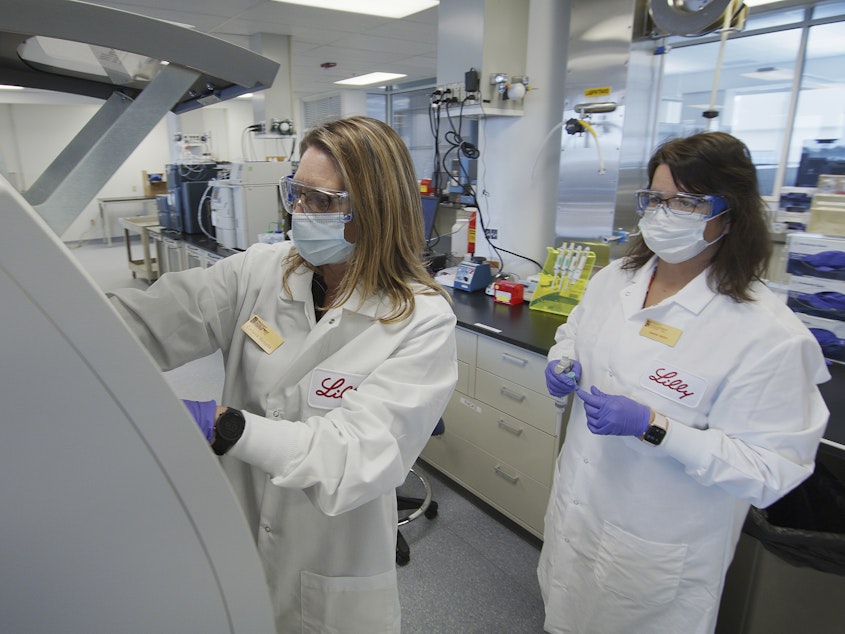How Will The Limited Supply Of Antibody Drugs For COVID-19 Be Allocated?

The Food and Drug Administration is evaluating two potential drugs that could help keep people healthy after they've been infected with the coronavirus.
So far, there's no clear system to make sure they would be allocated fairly or how to pay for these expensive drugs over the long haul.
"Demand is going to far outstrip supply here," says Rena Conti at Boston University's Questrom School of Business.
Even though manufacturers are gearing up to produce more than a million doses before the end of the year, some 50,000 Americans are getting infected every day, so the clamor for these drugs is likely to be considerable. (If the current pace of infection keeps up, there will be another 3.5 million infected Americans before the end of the year).
President Trump got a dose of one of these drugs and has told Americans that they, too, could get it at little or no cost.
Sponsored
But Conti doubts that. That would be unprecedented for an expensive medication in the United States, she says. "It's not realistic."
The drug itself could be free at first – since the federal government subsidized development and production of the product made by Regeneron and has promised to purchase the first stream of that product.
Conti says that's only part of the cost. These drugs are given by IV infusion, so they are expensive to administer. That must be done in a hospital or specialized infusion center.
Even people on Medicare have copays for many infused medicines. Copays are typically 20% of the price of a drug. If that pattern holds, the copay for these COVID-19 drugs could be many hundreds of dollars, considering Conti's estimate of a price tag in the range of $2,000 to $10,000 per treatment.
Then there is the question about how to allocate limited supplies.
Sponsored
Dr. Jewel Mullen, associate dean for health equity at the University of Texas' Dell Medical School, suggests using principles she helped develop as a member of the National Academies' study of COVID-19 vaccines.
That would mean giving highest priority to health care workers and first responders, "because we need them to be well," Mullen says. "They're protecting us all the time. They're putting themselves at risk all the time."
Mullen says the drug should then go to vulnerable people who stand to benefit most. The greatest benefit would be keeping the people at highest risk out of the hospital.
Her objective: "Maximize the benefit, make sure everyone is valued and thought about equally and address health inequities."
That means making sure populations hard hit by the pandemic, often poor communities and communities of color, get fair access, regardless of the cost of these medications.
Sponsored
Equitable distribution had been a huge challenge with another scarce COVID-19 drug, remdesivir.
"The difficulty with remdesivir was that it was predictably unpredictable," says Erin Fox, a pharmacist at the University of Utah. She was part of a committee charged with distributing the drug throughout her state, but there was no rhyme or reason to the supply that the federal government provided.
"And that was for a pretty narrow patient population," Fox notes – initially just seriously ill people in the intensive care unit. The monoclonal antibodies, by contrast, could be given to many more people — those who just got infected and aren't in the hospital.
If demand again sharply outstrips supply, Fox figures hospitals would be hard pressed to follow a rubric based on equity.
"If the amount that we get is so small, it's probably very likely that we would just use it for a short period of time," she says, "and just use it up and not try to make some very difficult rationing decisions."
Sponsored
Another huge challenge is figuring out how to get these drugs to wherever they are needed most, says Nada Sanders, a professor of supply chain management at Northeastern University. The federal government plans to send supplies to each state.
"Saying simply, 'We're going to leave it up to the state,' is not an answer," Sanders says.
Distribution is itself complicated and costly. Conti notes these drugs must be shipped in temperature-controlled trucks and sent to destinations that are equipped to handle them gingerly. And they need to get to rural areas coping with outbreaks.
"At the end of the day, someone has to pay for this," Sanders says.
Regeneron entered into a supply agreement with the federal government's Operation Warp Speed for around 300,000 doses of the antibody therapy. If the FDA grants emergency use authorization for the medicine, the government would then make those doses of the drug available free, a statement by Regeneron said.
Sponsored
Eli Lilly doesn't have a supply agreement with the government. It says it hopes to produce up to 1 million does by the end of the year, with the help of another drug company, Amgen.
Some of the eventual cost of treatment with the drugs could be borne could be through copayments. If insurance companies pick up the tab, those costs would ultimately be passed along in the form of premiums. State and federal taxpayers could also bear the brunt. It's not clear how the millions of uninsured Americans would have access to these drugs.
If the federal government has a plan, it hasn't been revealed. And the clock is ticking. The FDA has been considering emergency-use applications from Regeneron and Eli Lilly for two weeks now, and there's no saying how soon those deliberations will end.
You can contact NPR Science Correspondent Richard Harris at rharris@npr.org. [Copyright 2020 NPR]



